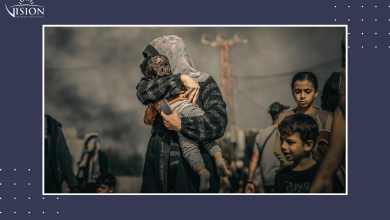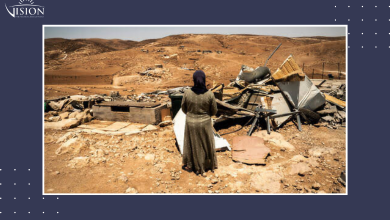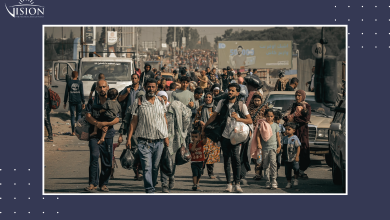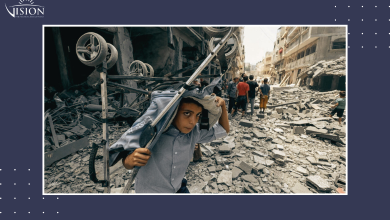Annexing the West Bank Through Economic Strangulation & Social (re)Engineering

Raghad Azzam
The Israeli government is executing a calculated economic strategy designed to suffocate Palestinian life in the West Bank, as part of advancing its unannounced annexation agenda. This strategy unfolds through a web of restrictive economic and security policies, including blocking trade movement, hindering investment, and systematically dismantling productive sectors. Through these strangulating measures, Israel seeks to construct a reality where Palestinians are left with no viable alternative but to accept their diminished status within an economy and infrastructure under constant Israeli domination. These actions are not only an assault on the Palestinian economy but also a deliberate effort to impose a stifling socioeconomic reality that forces Palestinians into a state of perpetual dependency, further entrenching Israel’s control over the region.
The repercussions of this strategy of controlling movement, reducing access to essential services, and undermining any possibility of Palestinian self-sufficiency extend far beyond the economy, reaching deep into the social fabric of Palestinian society. Through systematic demolition campaigns across the West Bank, repeated settler attacks on Palestinian villages and communities, and the imposition of severe restrictions on construction in Area C, the Israeli occupation seeks to obstruct urban expansion, increase population density and force overcrowding in Palestinian neighbourhoods and cities. Simultaneously, the destruction of critical infrastructure intensifies pressure on the population, creating a suffocating living environment aimed at coercing Palestinians into so-called “voluntary” migration—or entrapping them in a perpetual state of fear and uncertainty.
This report aims to analyze the successive Israeli policies in the West Bank and highlight their impact on (re)engineering the social reality in the region.
First: The Crisis of Public Sector Salaries
The crisis of public sector salaries in Palestine reflects deep structural imbalances, shaped by a complex interplay of political, economic, and financial forces. It is a multifaceted crisis that cannot be resolved without addressing the root causes of revenue shortfalls. However, the most significant contributing factor to this crisis is the Israeli confiscation of clearance revenues, which account for 54.2% of total public revenues and serve as the primary source for funding public sector salaries. In addition, a sharp decline in local tax revenues, which make up 24.9% of total revenues, has exacerbated the situation due to the severe economic contraction in the West Bank and Gaza, driven by the ongoing genocidal conflict. Furthermore, the drop in foreign aid—now contributing only 20.9% of revenues—has deepened the crisis, rendering it insufficient to cover salary expenses. These combined pressures have left the Palestinian Authority financially strained and worsened the already dire economic and living conditions for Palestinians in the West Bank.
Clearance revenues serve as the backbone of Palestinian government funding, yet they also act as a sword looming over the heads of Palestinians. The ongoing Israeli occupation’s repeated and escalating withholding of these funds drains the Palestinian treasury’s financial resources, further exacerbating the financial crisis. By the end of the third quarter of 2024, the Palestinian Authority had managed to pay approximately 71% of its outstanding obligations, with the majority directed toward salary and wage bills. Despite this, the amount still owed remains far greater than what has been actually paid, resulting in the continued accumulation of government arrears.
While retrieving the withheld clearance funds may not offer a permanent solution due to the structural imbalances in public finances and the decline in external support (both from the Arab and international communities) to minimal levels, the situation remains dire. Data from the third quarter of 2024 revealed that the government’s fiscal deficit reached approximately $96 million. Meanwhile, government debt increased by 21.4% year-on-year, reaching $4.1 billion, or 32.4% of GDP. As the debt burden grows, the government has become unable to secure additional funding from banks, as its debts are now classified as non-performing loans under external auditing standards. This deepens the financial crisis and limits the government’s ability to manage its financial obligations.
At the time of writing this paper, 70% of public employees’ salaries for the month of January 2025 have been disbursed, and the remaining dues will remain outstanding debts in favour of employees. The failure to pay salaries signals multiple issues within the local economy, as employees suffer from their reduced ability to cover basic needs such as food, housing, and education. This increases their reliance on borrowing, whether from banks or suppliers, leading to a rise in personal debts. As consumer spending declines, the trade and service sectors are directly affected, threatening the sustainability of small businesses and slowing down economic activity.
Socially, this situation deepens the sense of uncertainty among a wide segment of society, which adversely impacts family stability and increases levels of anxiety and stress. Additionally, the decline in employees’ purchasing power erodes the middle class, exacerbating social inequality and worsening poverty rates. Under such circumstances, protests and strikes become an expected response from employees, as seen in 2023, which could affect the performance of public institutions and essential services provided to citizens, further contributing to economic and social deterioration.
Second: The Deterioration of the Private Sector
The private sector in the West Bank witnessed a sharp decline as a result of the repercussions of the genocidal campaign in Gaza and the Israeli military escalation, leading to a broad contraction across various production and commercial sectors. Thousands of private sector enterprises have been adversely affected, with 29% of them ceasing operations either partially or entirely, while total output has decreased by 27%, equating to a loss of US$1.5 billion since the outbreak of the genocide, according to International Labour Organization (ILO) data.
One of the primary drivers of the economic collapse in the West Bank has been the suffocating network of military checkpoints and closures imposed by Israeli forces across Palestinian cities and villages. These deliberate restrictions have paralyzed the movement of workers and traders, effectively strangling economic activity. Entire sectors—particularly trade, logistics, and services dependent on intercity mobility—have been thrown into crisis. Workers are routinely unable to reach their jobs, productivity has plummeted, and key industrial and commercial enterprises have ground to a halt. Meanwhile, disrupted supply chains for raw materials and goods have slashed operational capacity for factories and businesses, driving up prices of basic commodities and deepening economic despair across the region.
Employment rates in the private sector suffered a sharp decline, with the sector in the West Bank, in particular, losing nearly one-fifth of the available jobs, marking a 20% drop compared to the pre-war period. The construction sector saw a 21% reduction in workforce, the industrial sector declined by 22%, and the trade and services sector experienced a 15% decrease. This decline directly impacted the income levels of Palestinian households across the West Bank.
Under these circumstances, the labour market crisis has worsened to unprecedented levels. The closure of the Israeli labour market to Palestinian workers has led to an increase in local unemployment rates. While the private sector, despite its economic struggles, became the primary refuge for laid-off workers, it was unable to absorb the large numbers of unemployed individuals. This resulted in increased competition for available jobs, lower wages, and the spread of informal labour lacking even the most basic social protections.
As this crisis continues, it has become clear that the economic impact of the war will last for a long time, threatening social and economic stability in the West Bank. This decline is not only reflected in the numbers, but also in the daily lives of citizens, where it has become increasingly difficult for workers and small business owners to maintain their sources of income amid these deteriorating conditions.
Third: Restrictions on the Labour Market
The prevention of Palestinian workers from accessing the Israeli labour market highlights the fragility of the Palestinian economy and its structural dependence on this vital source of income. The restrictions on issuing work permits for Palestinian workers have led to significant economic and social repercussions. According to available statistics, Palestinian workers in Israel constituted about 17% of the workforce in the West Bank and Gaza before the recent Israeli aggression on the Gaza Strip. With the tightening of work permits, unemployment has sharply risen, reaching 51% by the end of 2024, with Gaza’s unemployment rate hitting 80%. Moreover, the Palestinian Authority incurred losses of about $50 million annually in revenue that it had previously collected from labour taxes on workers in the Israeli labour market. Additionally, the cessation of labour remittances, which had been a primary source of liquidity in the Palestinian market, has caused a slowdown in investment and a weakening of small and medium enterprises (SMEs).
The local market was unable to absorb the displaced workers, leading to the loss of the primary source of income for tens of thousands of Palestinian families. This has diminished their ability to meet basic needs, exacerbated by inflationary pressures that weaken individuals’ purchasing power. These challenges have had a direct impact on health, education, and nutrition levels, especially among the most vulnerable groups. This situation has resulted in declining wages, a rise in informal labour, and deteriorating working conditions, all amidst a lack of social protection.
The decline in incomes and the increasing loss of jobs have led to a surge in non-performing loans, raising banking risks and triggering a severe liquidity crisis. In addition, the lack of opportunities has led many young people to migrate or seek unstable sources of income, including working in exploitative or illegal conditions. Together, these factors have widened the social gap, increased the burden on social protection systems, threatened community stability, and deepened the challenges faced by vulnerable groups, particularly women and children.
Fourth: The Brutal Assault on Northern West Bank
The cities of northern West Bank, particularly Jenin and Tulkarem, are witnessing an unprecedented Israeli assault, manifesting in violent military operations that include repeated incursions, heavy bombardment, and widespread demolition of homes and infrastructure. The aim is to impose a new reality in the West Bank, characterized by increased settlement expansion, the expulsion of Palestinian populations, and the imposition of further security and military control. Most importantly, it seeks to create a long-term demographic shift. These attacks, targeting cities in northern West Bank, including refugee camps that stand as living symbols of Palestinian suffering since the Nakba, have resulted in the displacement of hundreds of families after their homes were destroyed or rendered uninhabitable. The damage has not been limited to residential buildings but has extended to major roads and essential networks such as electricity and water, disrupting the daily lives of citizens, making it harder for them to reach workplaces or educational institutions.
In light of this brutal reality, displaced Palestinian families are grappling with extreme and deteriorating living conditions, after being violently uprooted from their homes and communities. With no access to alternative housing or compensation for the widespread destruction, many have been forced to flee to overcrowded and insecure areas. This wave of forced displacement has devastated family livelihoods, as countless Palestinians have lost their only sources of income due to the systematic demolition of shops and the near-total paralysis of economic life caused by relentless closures and military sieges. Poverty and unemployment have soared to alarming levels, particularly as Israel’s assaults have obliterated markets, factories, and workshops—collapsing the backbone of key economic sectors and pushing entire communities to the brink of survival.
In addition to the economic devastation, Israel’s military onslaught has ripped through the core of Palestinian society, unravelling its social fabric and displacing families from the communities that once anchored their lives. Entire families have been violently uprooted from their homes, scattered across distant and unfamiliar areas—severing communal ties and dismantling the cohesion that once held neighbourhoods together. This forced displacement has unleashed a wave of psychological trauma and social distress. As families struggle with the trauma of uprooting, livelihood constraints, economic despair, and unliveable conditions, tensions have soared, familial pressures and mental health crises have multiplied, and the foundations of community life have begun to unravel under the weight of relentless aggression.
These Israeli policies are not isolated but are part of a broader strategic agenda to reshape the Palestinian demographics in the West Bank. Through intensifying destruction and demolitions, the occupation seeks to evacuate certain areas of their Palestinian populations, forcing them to move to more crowded areas. This facilitates the control of their land and its annexation to the growing Israeli settlements. This strategy aims to create a new geographical reality that traps Palestinians in isolated pockets, resembling ghettoised cantons, while expanding settlements and connecting them with modern road networks that reinforce Israeli dominance over the land.
Fifth: The Energy Annexation Plan
On October 31, 2024, the Israeli government made a decision to build two power generation plants in the West Bank and allocate 2,000 dunams for photovoltaic solar energy projects. These new projects include the construction of two electricity generation plants with a total capacity of at least 1,300 megawatts, aimed at meeting the needs of Israel and its settlements, with a portion of the electricity allocated for Palestinians.
This decision is part of the “Economic Plan 2025” which aims to “enhance Israel’s energy security” by expanding energy infrastructure within Palestinian territories and annexing more land for the benefit of the occupation. This land will be used to generate electricity for Israel, increasing Palestinian dependence on Israeli electricity. This step is part of the “Energy Annexation” policy, which exploits Palestinian resources for the benefit of the occupation, contrary to international law that prohibits the exploitation of occupied land for the benefit of the occupying power[1].
Palestinian consumption accounts for about 10% of the total electricity produced in Israel, and Israel benefits from selling electricity to the Palestinian Authority at high prices. Despite attempts to reduce reliance on Israeli energy by importing it from Jordan or establishing a power station in Jenin, Israel continues to monopolize the electricity sector in the West Bank.
The Israeli government aims to allocate 2,000 dunams for solar energy fields in the West Bank for the benefit of settlers and Israeli businessmen, while Palestinians face difficulties in establishing similar projects due to Israeli control over 60% of the land in Area C. Israel continues to capitalize on this Palestinian dependence on Israeli energy, further strengthening its economic and political dominance, and increasing the annexation of Palestinian land.
This situation exacerbates the living burdens on Palestinian families, as electricity, water, and essential service prices are impacted by Israeli tariffs and taxes imposed by the occupation. Moreover, frequent power outages, caused by deliberate Israeli policies or financial restrictions imposed on the Palestinian Authority, negatively affect hospitals, schools, and productive sectors, disrupting vital services.
Conclusion
In the face of these harsh conditions, the Palestinians are confronted with a fateful challenge to preserve their existence and national identity amidst ongoing attempts to force their displacement. Despite all these practices, the Palestinians continue to resist, relying on internal social cohesion and relief efforts. However, if this aggression persists without genuine international intervention, it will lead to further deterioration of the humanitarian and economic situation in the West Bank.
The confiscation of VAT funds and the hijacking of the Gaza Strip’s tax revenues by the occupation has led to a crippling salary crisis that has impacted the local economy and social stability. Additionally, the deterioration of the private sector due to closures and security restrictions has contributed to rising unemployment rates, while the ban on Palestinian workers from working in Israel has complicated the crisis, leading to higher poverty rates and widening of social inequalities.
On the other hand, the Israeli assault on the northern West Bank, accompanied by demolitions and forced displacement, aims to reshape the demographic landscape in favour of settlement expansion. Meanwhile, the plan to annex energy resources is part of a broader strategy to control Palestinian resources and reinforce the economic dominance of the occupation. Through these strangulating policies, Israel seeks to keep Palestinians in a state of economic dependency and forced reliance, subjecting them to impossible living conditions that push them toward the “voluntary” migration option, which the ruling right-wing in Israel openly advocates and is actively working to implement.
International humanitarian law stipulates [1] that the occupying power is obliged to ensure that the economic resources of the occupied territories are not exploited for its benefit but for the benefit of the local population. Any demographic or economic changes imposed by the occupying power to exploit resources for its own advantage are prohibited.





